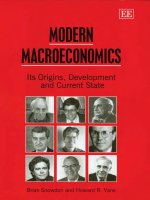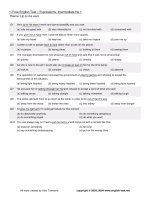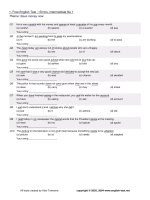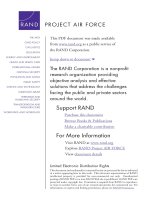Intermediate macroeconomics chapt12
Bạn đang xem bản rút gọn của tài liệu. Xem và tải ngay bản đầy đủ của tài liệu tại đây (397.88 KB, 28 trang )
Chapter 12:
Aggregate Demand
in Open Economy
The Mundell-Fleming Model
Assumption
– Small open economy
– Free capital mobility (r = r*)
– Flexible or fixed foreign exchange rate regime
Flexible Exchange Rate
The IS curve:
Y = C(Y – T) + I(r*) + G + NX(e)
Where e = nominal exchange rate that varies according to
its demand and supply
An increases in e make imports less expensive to
domestic consumer and exports more expensive to foreign
consumer, hence reducing NX
Derivation of IS Curve
Initial equilibrium: Y = E1 with Y1 and e1
Let e increase, NX decreases and E1 falls to E2
New equilibrium: E2 = Y with Y2<Y1 and e2>e1
Line AB is the IS
Derivation of IS Curve
Expenditures
Exchange Rate
Y=E
E1
E2
e2
e1
B
A
IS(e)
Y2 Y1
Income
Y2 Y1
Income
Derivation of LM Curve
M/P = L(r*, Y)
LM is independent of the exchange rate
Shift of LM won’t alter the interest rate because r = r*
Derivation of LM Curve
Interest Rate
Exchange Rate
LM(r*)
LM(e)
r = r*
r
Y
Income
Y
Income
IS-LM Model
Exchange Rate
LM
Aggregate Equilibrium
e
IS
Y
Income
Fiscal Policy
Initial equilibrium: IS1 = LM1 with Y1 and e1
As G increase, IS increases. New equilibrium: IS 2 = LM1
causing Y and e to increase
The rise in e makes NX and Y to fall, offsetting the initial
increase in income
Fiscal Policy
Exchange Rate
LM
Fiscal policy is ineffective
in causing economic growth
e2
e1
IS1
Y
IS2
Income
Monetary Policy
Initial equilibrium: IS1 = LM1 with Y1 and e1
As M increase, LM increases. New equilibrium: IS1 = LM2
causing Y to increase and e to fall
The fall in e makes NX and Y to increase
Monetary Policy
Exchange Rate
LM1 LM2
Monetary policy is effective
in causing economic growth
e1
e2
IS1
Y1
Y2
Income
Trade Protectionism
Initial equilibrium: IS1 = LM1 with Y1 and e1
Let imports decrease, NX and IS decline. New equilibrium:
IS2 = LM1 causing Y and e to increase
The rise in e makes NX and Y to decrease
Trade Protectionism
Exchange Rate
LM
Trade protectionism is ineffective
in causing economic growth
e2
e1
IS1
Y
IS2
Income
Fixed Exchange Rate
Assume: market rate > fixed rate
Arbitrageur buys from the market and sells to the central
bank at the fixed rate and make profits
Money supply and LM increase, causing Y to increase.
The market rate falls to the fixed rate
Fixed Exchange Rate
Exchange Rate
LM1 LM2
em
ef
IS1
Y1
Y2
Income
Fixed Exchange Rate
Assume: market rate < fixed rate
Arbitrageur buys from the central bank market and sells to
the market at the fixed rate to make profits
Money supply and LM decrease, causing Y to fall. The
market rate rises to the fixed rate
Fixed Exchange Rate
Exchange Rate
LM2 LM1
ef
em
IS1
Y2
Y1
Income
Fiscal Policy
Initial equilibrium: IS1 = LM1 with Y1 and e1
As G increase, IS increases, causing e to rise above the
fixed rate.
Exchange rate arbitrage causes Ms and LM to increase, e
falls to the fixed rate
New equilibrium: IS2 = LM2 causing Y to increase
Fixed Exchange Rate
Exchange Rate
LM1 LM2
Fiscal policy is effective
in causing economic growth
em
ef
IS1
Y1
Y2
IS2
Income
Monetary Policy
Initial equilibrium: IS1 = LM1 with Y1 and e1
Let Ms increase, LM increases, causing e to decrease
below the fixed rate.
Exchange rate arbitrage causes Ms and LM to decrease, e
rises to the fixed rate
New equilibrium: IS1 = LM1 causing no increase in Y
Monetary Policy
Exchange Rate
LM1 LM2
Monetary policy is ineffective
in causing economic growth
ef
em
IS1
Y2
Y1
Income
Trade Protectionism
Initial equilibrium: IS1 = LM1 with Y1 and e1
As imports increase NX and IS increase, causing e to
increase above the fixed rate
Exchange rate arbitrage causes Ms and LM to increase,
lowering e to the fixed rate
New equilibrium: IS2 = LM2 causing Y to increase
Trade Protectionism
Exchange Rate
LM1 LM2
Trade protectionism is effective
in causing economic growth
em
ef
IS1
Y1
Y2
IS2
Income
Policy Effectiveness
Policy
Flexible Exchange
Rate
Fixed Exchange
Rate
Fiscal
Monetary
Trade Protectionism
Ineffective
Effective
Ineffective
Effective
Ineffective
Effective









